|
"----we cannot
escape the evident fact that Polynesian material culture was never based
on pottery-making. It was, from the earliest stage of the
Maori-Polynesian departure into the ocean, based on and typified by a
stone-lined earth oven, in which food was baked between heated stones,
as a substitute for cooking in waterproof earthenware."--------1952,
Thor Heyerdahl, "American Indians In The Pacific." p. 40.
"Sometime
before 200 A.D. a new wave of invaders from Southeast Asia appears to
have arrived in the western Pacific. This seafaring aristocracy
introduced earth ovens and well-digging which reduced the need for
pottery."----2000,
Brij V Lal & Kate Fortune, "The Pacific Islands, An Encyclopedia," p.
133.
"Liquids were also boiled or heated by plunging
a hot stone into them."---------2000,
Brij V Lal & Kate Fortune, "The Pacific Islands, An Encyclopedia," p.
441.
"The methods of cooking among the meat
eating tribes were, in order of importance, broiling, roasting, boiling,
the last named process often being that known as "stone boiling."------1912,
Frederick Webb Hodge, "Handbook Of American Indians North Of
Mexico, (Smithsonian publication)," p. 468.
"Cooking stone--Any stone heated for a long time or
several times by being place in water or stew in order to convey heat to
the water or stew."----2007,
Barbara Ann Kipfer, "Dictionary Of Artifacts," p. 80.
"Poverty point
objects functioned as the heating element for earth ovens."----1983,
Dan F. Morse & Phyllis A. Morse, "Archaeology Of The Central
Mississippi Valley," p. 125.
"It
(clay) was also used to produce the diagnostic "poverty point objects,"
masses of various shapes, about fist size, apparently used in place of
rock in hot-stone cooking in pits."----1990,
John A. Walthall, "Prehistoric Indians Of The Southeast,
Archaeology Of Alabama And The Middle South," p. 86.
"The wide valley
floor of the lower Mississippi has very little rock; and people who
wished to use the technique of "stone boiling" had to make their own
"stones" out of clay in order to cook their food."----1978,
Jesse D. Jennings, "Ancient Native Americans," p. 297.

COOKING STONES & EARTH OVENS
32,000 YEARS AGO TO PRESENT
DAY
WORLDWIDE
Cooking stones are very simple tools. They may
be compared to hammer stones and unmodified utilized flakes in their
simplicity. Although they aren't pretty to look at, they do represent a
unique tool form. People around the world have used them for tens of thousands of years.
In fact, they are one of the oldest stone tool types that have been used
by modern humans. |
|
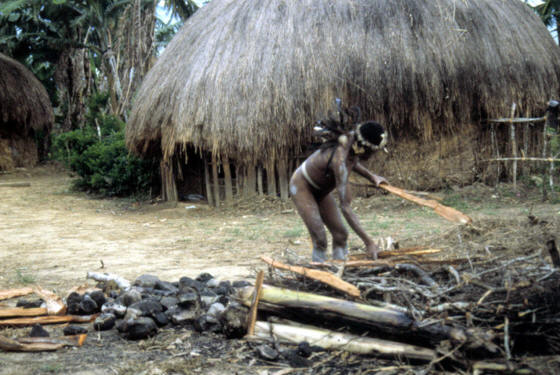
FROM LITHIC CASTING LAB'S COLLECTION OF
ORIGINAL IMAGES
CLICK ON PICTURE FOR LARGER IMAGE
PREPARING FIRE TO HEAT
STONES
BALIEM VALLEY, WEST PAPUA,
INDONESIA
ISLAND OF NEW GUINEA
This picture shows a Dani man in the
process of building a large fire for the purpose of heating stones.
The heated stones are later transferred to a grass lined pit where
food is cooked. The best cooking stones are made of dense
homogeneous rocks. Basalt and some types of volcanic rocks can make
good cooking stones. Some
stones wear out sooner from thermochemical heat weathering and begin to
lose their ability to hold heat with each cycle of heating. The
stones eventually have to be replaced with new stones. |
|
|
The earliest use
of heated stones in earth ovens are reported from Europe and Japan as
early as 32,000 years ago. They are reported to be 20,000 years old in
the Middle East. The earliest use in
North America date to the Archaic period between 8,000 and 9,000 years
ago. |
|
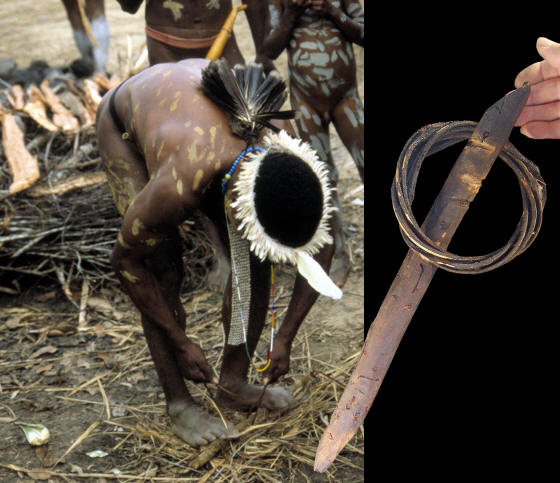
FROM LITHIC CASTING LAB'S COLLECTION OF
ORIGINAL IMAGES
CLICK ON PICTURE FOR COMPLETE IMAGE
MAKING FIRE WITH STICK &
RATTAN VINE
BALIEM VALLEY, WEST PAPUA,
INDONESIA
ISLAND OF NEW GUINEA
This Dani man is
lighting a fire to heat cooking stones. He is using a traditional
fire-by-friction technique referred to as a fire thong. The stick is
held by the feet and the rattan vine is pulled back and forth until
enough heat is produced to ignite dust and dry fibers. |
|
|
Hot stones have been used to cook food in earth ovens,
steaming pits, in container stone boiling, and open-air griddle cooking.
Earth ovens are one of the more common techniques that involves baking
the food in covered pits below ground. Sometimes an additional fire was
added on top. Steam-pit cooking was also done below ground in
grass-lined and grass covered pits where water could be poured for
additional steam. Cooking stones were also used above ground for
open-air grilling over hot stones. Another cooking process, called stone boiling, involves placing hot stones in bark-lined pits, baskets or any
other container to heat liquids. |
|
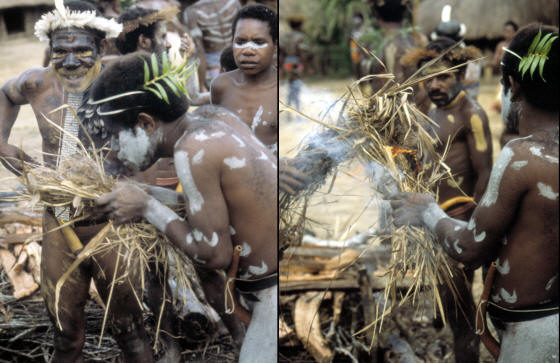
FROM LITHIC CASTING LAB'S COLLECTION OF ORIGINAL IMAGES
CLICK ON PICTURE FOR LARGER IMAGE
IGNITING SPARK ON GRASS
BALIEM VALLEY, WEST PAPUA,
INDONESIA
ISLAND OF NEW GUINEA
These two pictures show a fire that was
just produced from the fire thong process of fire-by-friction. The
fire was used to light a large pile of wood for the purpose of
heating cooking stones. |
|
|
Archaeologists use the term "carbohydrate revolution"
in reference to a major diet change during the Archaic period in North
America's southern Plains and southeastern Woodlands between 8,000 and
9,000 years ago. The best evidence of this change are fire cracked rocks
that were used in earth ovens for the purpose of baking-plants. People
began eating a diet of insulin-rich root foods such as onions, camas,
agave and sotol. These types of foods required a
prolonged cooking period that earth ovens could provide. |
|
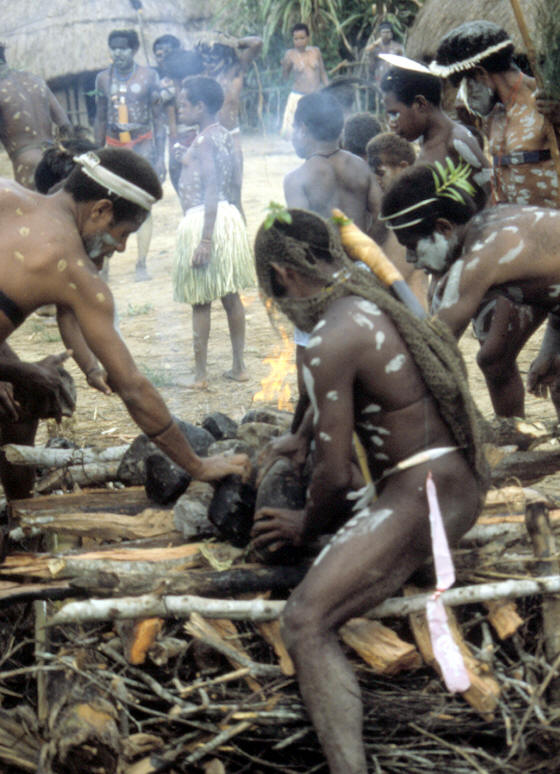
FROM LITHIC CASTING LAB'S COLLECTION OF
ORIGINAL IMAGES
CLICK ON PICTURE FOR LARGER IMAGE
IGNITING A PILE OF WOOD TO
HEAT COOKING STONES
BALIEM VALLEY, WEST PAPUA,
INDONESIA
ISLAND OF NEW GUINEA
This picture shows several Dani men
placing the last few cooking stones on a large pile of wood that is
being lit by fire that was produced by a fire thong fire by friction
technique. |
|
|
Earth ovens vary in size. In North America, they can range in
size from about three feet across to nine feet. The many pieces of fire cracked stones
that have been found in them can weigh as much as 2,000 pounds. |
|
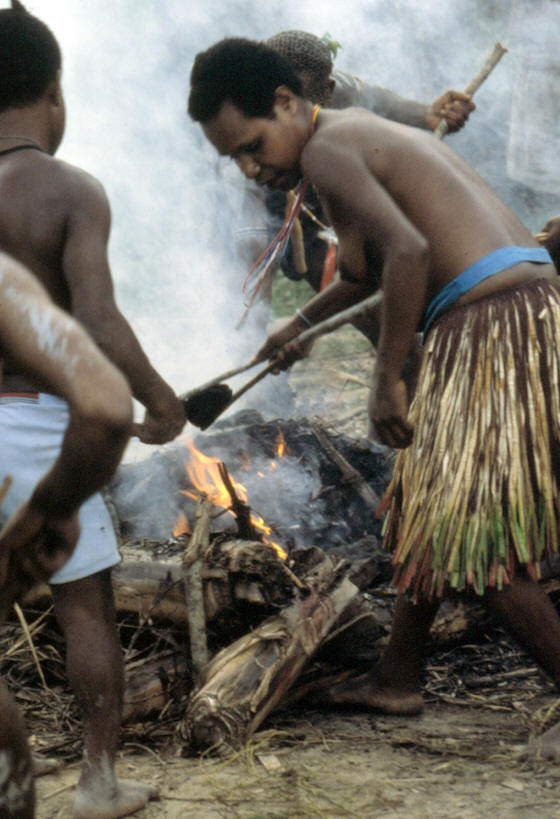
FROM LITHIC CASTING LAB'S COLLECTION OF ORIGINAL IMAGES
CLICK ON PICTURE FOR LARGER IMAGE
REMOVING HOT COOKING STONES FROM FIRE
BALIEM VALLEY, WEST PAPUA,
INDONESIA
ISLAND OF NEW GUINEA
This picture shows the process of removing
hot cooking stones from the fire that was used to heat them. They
are using split limbs to carry the stones over to a grass lined pit
where the food will be cooked. |
|
|
The best cooking stones are made of dense homogeneous
rocks. Basalt and some types of volcanic rocks can make good cooking stones. Some
stones wear out sooner from thermochemical heat weathering and begin to
lose their ability to hold heat with each cycle of heating. The
stones eventually have to be replaced with new stones. |
|
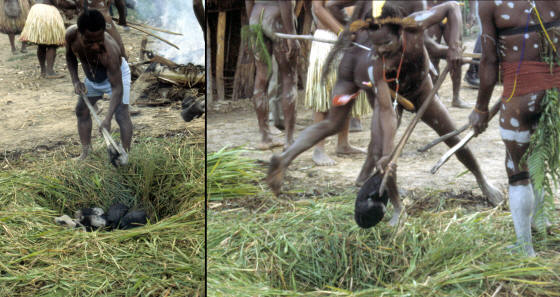
FROM LITHIC CASTING LAB'S COLLECTION OF ORIGINAL IMAGES
CLICK ON PICTURE FOR LARGER IMAGE
PLACING HOT STONES IN GRASS
LINED PIT
BALIEM VALLEY, WEST PAPUA,
INDONESIA
ISLAND OF NEW GUINEA
This picture shows Dani tribesmen placing hot
cooking stones in a grass lined pit where yams and pig meat will be
cooked. They are using split limbs to carry the stones. |
|
|
It's interesting to note that all stones can not be
heated to cook food. A good example of this can be seen in
fireplaces that have been built, by mistake, from stones that fracture
when heated like
chert, flint, chalcedony, etc. The first time they are fired up the
stones fracture and send pieces flying making the fireplace useless. |
|
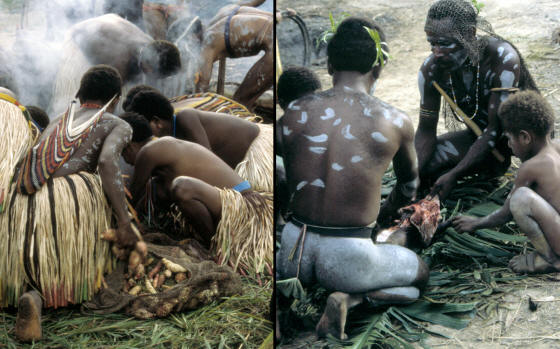
FROM LITHIC CASTING LAB'S COLLECTION OF
ORIGINAL IMAGES
CLICK ON PICTURE FOR LARGER IMAGE
PLACING YAMS & MEAT IN
GRASS LINED PIT
BALIEM VALLEY, WEST PAPUA,
INDONESIA
ISLAND OF NEW GUINEA
The
picture on the left shows Dani women placing yams in a grass lined
earth oven cooking pit and the picture on the right shows the men placing pig
meat in the pit. |
|
|
Cooking stones have been found that weigh over 30 pounds. But
a standard size seems to be about twice the size of a man's fist. Larger
stones are reported to be about 3 to 4 inches thick and 12 inches
across. |
|
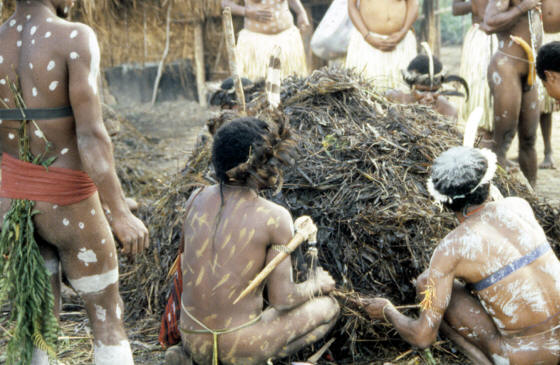
FROM LITHIC CASTING LAB'S COLLECTION OF
ORIGINAL IMAGES
CLICK ON PICTURE FOR LARGER IMAGE
TIGHTENING GRASS MOUND
ABOVE OVEN
BALIEM VALLEY, WEST PAPUA,
INDONESIA
ISLAND OF NEW GUINEA
These Dani tribesmen are capping off
an earth oven with a large pile of grass and tightening the mound
with vines. |
|
|
The process of heating cooking stones and the building of an
earth oven are illustrated in this report by people of the Dani tribe in
West Papua. A fair amount of labor is involved. A fire to heat the
stones is started with a fire thong. Then a pit is dug and lined with
grass. The heated stones are transported to the pit with wooden sticks.
Then food is added by Women who put in the yams and by men who bring the pig meat.
The pit is covered with a large bundle of grass and left to cook for one
or two hours. |
|
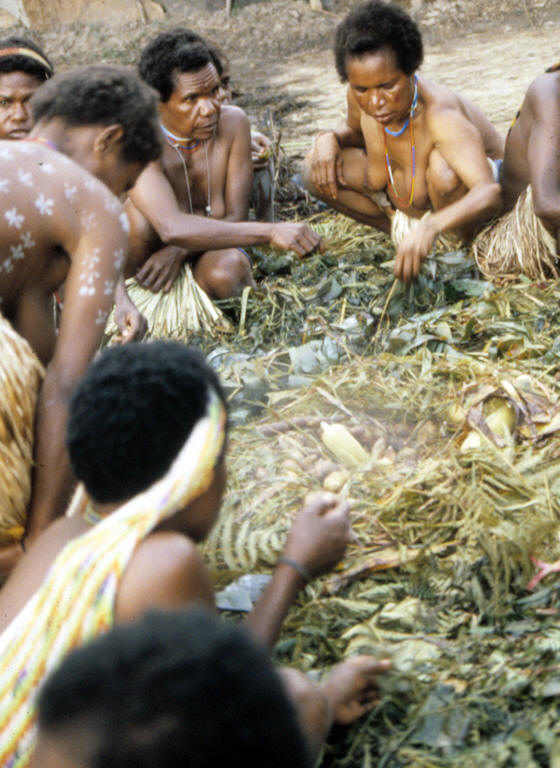
FROM LITHIC CASTING LAB'S COLLECTION OF
ORIGINAL IMAGES
CLICK ON PICTURE FOR LARGER IMAGE
REMOVING COOKED FOOD FROM
EARTH OVEN
BALIEM VALLEY, WEST PAPUA,
INDONESIA
ISLAND OF NEW GUINEA
This picture shows the removal of
food that was cooked with hot stones in a grass lined earth oven. |
|
|
The use of earth ovens were guided, in some ways, by local
resources. In areas where there was no clay to make ceramic cooking
pots, like islands in the Pacific, earth ovens were commonly used to
cook food. Another example can be found in the southeastern U.S. where
cooking stones were not readily available. In their place, fire hardened
clay balls, called Poverty Points, were used instead. |
|
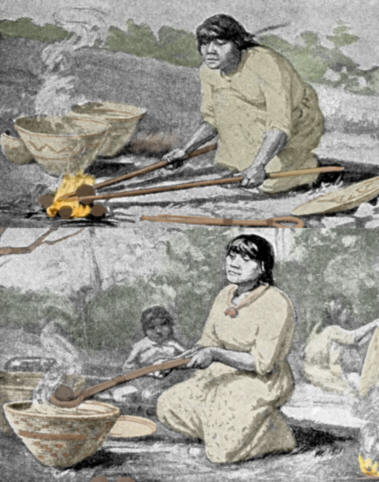
FROM 1912
SMITHSONIAN: "HANDBOOK OF AMERICAN INDIANS NORTH OF MEXICO"
HOT STONE BASKET
BOILING
NORTH AMERICA NATIVE
AMERICAN INDIANS
These drawings
illustrate a technique called stone boiling. Hot stones or fire
hardened clay balls could be placed in baskets to heat food. |
|
|
Poverty Points were named after the Poverty Point
site in northeastern Louisiana and the late Archaic culture by the same
name. These people are famous for using clay balls, that were made in
several different shapes, to cook food. The clay balls were heated and
as many as 200 were used in earth ovens to cook food. |
|
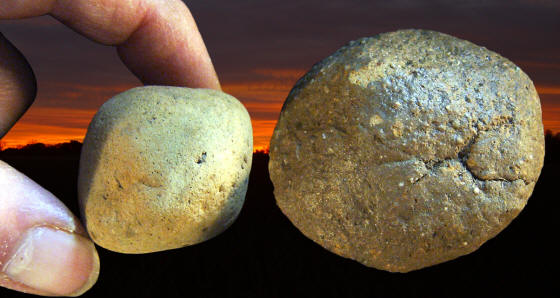
POVERTY POINT COOKING
BALLS
SOUTHERN ILLINOIS
This picture shows two examples of fire
hardened clay cooking balls that are called Poverty Points.
Poverty Points were named after the Poverty Point site in
northeastern Louisiana and the late Archaic culture by the same
name. These people are famous for using clay balls, that were made
in several different shapes, to cook food. The clay balls were
heated and as many as 200 were used in a pit for cooking food. |
|
|
Earth oven cooking stones have been used all
over the world and date to nearly the beginning of modern humans in
Europe. The fact that they have been in use non-stop for 32,000 years
makes them one of the longest continuously used stone tool types by
modern humans. |
|
"REFERENCES"
1912, Hodge, Frederick Webb,
"Handbook Of American Indians North Of Mexico, (Smithsonian
publication)."
1952, Heyerdahl, Thor, "American Indians In The Pacific."
1978, Jennings, Jesse D., "Ancient Native Americans."
1983,
Morse, Dan F., & Morse, Phyllis A., "Archaeology Of The Central
Mississippi Valley."
1990, Walthall, John A., "Prehistoric Indians Of The Southeast,
Archaeology Of Alabama And The Middle South."
2000, Lal, Brij V & Fortune, Kate, "The Pacific Islands,
An Encyclopedia."
2007, Kipfer, Barbara Ann "Dictionary Of Artifacts."
2007, Graham, Dale, "Fire-Cracked Rocks And The Carbohydrate
Revolution," Mammoth Trumpet, Vol. 22, No., 1.
2008, Thoms, V. Alston, "Ancient Savannah Roots Of The
Carbohydrate Revolution In South-Central North America," Plains
Anthropologist, Vol. 53, No. 205.
|
|
RECENT
LISTINGS HOME
ORDERING |